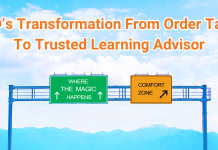
You probably know about the concept of cause and effect, AKA causality. It’s the relationship between an event (the cause) and a second event (the effect), when the effect is the direct result of the event. Cause and effect play a large role in Corporate Culture…
Let's dive further. For instance, if you hit your thumb with a hammer (the cause), your thumb is going to hurt (the effect.) Often we can figure out the cause simply by looking at the effect. In this example, if you see a smashed thumb and a hammer nearby, you can be pretty confident that the cause of the injury was the hammer.
But when it comes to people, particularly in relation to corporate culture and specifically declining innovation cause and effect can get more than a little fuzzy.
Angry Executives Case Study
Let’s take a look at two high-level executives: Michael and Linda have just come out of a meeting. Both are angry at the way things are going in the company and secretly both of them are thinking about finding a new opportunity.
If you, as their manager, look back at what happened in the meeting, you will see that Michael and Linda had disagreed about how to proceed with the next step in implementing a new marketing plan. No big deal, it happens all the time…right? Sure, there had been some heated discussion, and it seemed like the compromise you worked out had been satisfactory to both of them. At least they seemed okay when they left the meeting, so you would be stunned to learn that both of them had had their corporate loyalty shaken, and they were thinking about leaving the company.
Old-School Solution
Two of your top talented people are looking to leave you, and you don’t want to lose either of them, let alone face the nightmare of having to find the right person to replace them. So what do you do?
Well if you are an old school more traditional leader, you might call them in to your office one at a time and offer each of them a raise. Or perhaps maybe a better office, a closer parking spot—any of the perks that go along with rewarding performance. Of course you would be careful to make sure that what you gave each of them was comparable, so that there wouldn’t appear to be any favouritism… (Unless you made different offers and then swore them to secrecy.)
They leave your office and appear to be happy. You breath a sigh of relief and tell yourself that you’ve done well, having obverted a hiring crisis, corporate culture and loyalty reestablished. In that moment you cross Michael and Linda’s issues off your list and move on to what you believe are more pressing problems.
The following week, Michael and Linda both come into your office and drop the bomb, hand in their resignations, …feeling gobsmacked? It feels like your brain just blew out of your ears…Why on earth would they still be unhappy?
The reason is that you were looking at the result (their dissatisfaction at work) and you assumed the cause of their discontent was the same—lack of perks and or lack of respect.
And guess what… that’s where you would be completely wrong.
Yes, the result—quitting—was the same, but the reasons, even for two executives at the same corporate level couldn’t have been more different.
Corporate Culture Loyalty Cause and Effect… Same Result But Very Different Causes
Working with high-level leadership teams we see this kind of thing played out all the time, before we come in. There is often an assumed cause for an effect and until mastered soft skills and become what I call a “C.R.O” (Chief Relationship Officer) the majority of the time it’s easy to miss the real cause and both corporate culture and loyalty fast begins to fade.
Here’s what I mean: From Michael’s point of view, Linda refused to compromise on anything. He secretly thought Linda was a bit of a bitch, (not politically correct, nonetheless it was how he felt) and often found himself calling her that in the safety of his own mind. As such, working together was becoming increasingly difficult. He figured that Linda and her department were being overprotective and unwilling to communicate openly with other departments.
Switching perspectives….
Linda, on the other hand, saw the situation entirely differently. This was not the first time she had butted heads with Michael, in fact early on she enjoyed the challenge of it because the boss they had both had when she started made it a point to always keep the lines of communication open.
As a result Linda would always leaves these meetings inspired to be creative, to innovate new and better solutions.
So, from her point of view there was more at stake than personal opinions. Linda was committed to the vision, mission, and purpose of this organization (all about the corporate culture).
After all, it was those things that won her over and got her to leave her former a very well paid position. She felt that the minute anyone in the company began compromising on those things that was the minute she would begin to look elsewhere. And that minute had arrived at 85 mph in that last meeting with Michael.
Think about what this means. Do you see that without the specific skills needed, assuming cause can be disastrous! This is why it would be absolutely essential for you, as a leader, to learn what was really behind Michael and Linda’s (or anyone in your organization) decisions if you wanted to keep their talent in your organization?
Let me be crystal clear, “fixing” it won’t be as easy as offering a new parking spot, but then offering the new parking spot, or even a raise isn’t going to work…at least not for long.
What To Do
What can you do?
Actually before we go any further, let’s bring it back to basics: Why should you even care about Linda and Michael’s reasons for leaving the company? Good riddance… right? Wrong! And here’s why:
You need to care because, in a recent global study it was found that the number one challenge facing top executives like yourself is loyalty! In other words, getting the super talented to stay with the organization and be fiercely loyal is the single most difficult task facing those at the top.
Speaking of cause and effect, here’s the bit that might be a little difficult to swallow: Much of the challenge is, I’m sorry to say, a leadership issue. Here’s why; whether we admit it or not, its our leadership that forms culture. A leader who has not embraced the power of authenticity, vulnerability and connection is not demonstrating real courage, and in turn that kind of leader is consciously or otherwise generating a lack of emotional safety and when that happens corporate culture and loyalty is out the window.
The Romance Of Business
Business is not that different that primary romantic relationships. What I mean by that is, if you have ever had a serious relationship you know as well as I do; there have been times when you are having a fight with your loved one and it seems like they have a bout of temporary insanity. You have no idea what the heck they are really upset about. In fact they may very well be upset about something you were certain had been resolved. Frustrating isn’t it?
A Corporate Culture of Resentment
On one of my radio show (The Authentic Leadership Show) I had the honour of interviewing many outstanding leaders, one of whom was hard-core trial lawyer turned peacemaker, who specializes in difficult, complex, and intractable conflicts, by the name of Doug Noll. (You can find the interview here: http://fullmontyradio.com/leadership/doug-noll-full-monty-leadership-radio)
In that interview, Doug and I spoke about the misconceptions of peace. One of the subjects we covered was how carrying a fear of conflict actually ends up creating resentment and resentment is a precursor to escalated conflict.
It is this resentment that becomes an underlying cancer that will eat away at the fabric of your organizations culture.
Once the fabric of your culture begins to erode, you are going to have major problems keeping your top talent.
Before we go any further, I want to set something straight. To have a healthy corporate culture that has an ongoing momentum of growth, healthy conflict must not only be encouraged, a team must be trained in how to facilitate healthy conflict amongst themselves and with those they lead.
The (Real) Number One Fear
We’ve all heard the fear of public speaking is the number one fear people have…right? Well you know what? I don’t believe it for a moment. I am the president of The Authentic Speakers Academy for Leadership and we have had everyone from top corporate executives to self-employed moms in the program and getting them over the fear of public speaking is far easier than getting someone to face the real number one fear; facing anything that even resembles real conflict. There is a common root in the two: Fear of conflict, much like stage fright, has its root in a fear of rejection.
An Safe Place To Create and Innovate.
One vitally important last and final point: Creating a safe place for conflict means, by its very nature, creating a safe place for innovation. Here’s why, your team cannot innovate in an environment where they are in fear of rejection,
I realize that you may never have considered that fear of conflict is massively detrimental to both the creativity and growth of the individual. Try to grasp it’s not much of a logical leap to realize that the stunted growth of the individual will, in turn, stunt the growth of your team and ultimately the whole organization within a reasonable short order.
In the simplest of terms, what’s happening with individuals is going to impact the entire organization.
That’s where authentic, effective, and vulnerable leadership plays a major role.
The fact is a leader must have an effective strategy to healthily deal with conflict. Developing healthy conflict skills not only deepens understanding. It also generates a greater bond between the individuals involved, but it also creates a greater bond to the organization.
Another name for that bond is Fierce Loyalty! This is a topic I explore in depth in my new book Fierce Loyalty, which you can order at: Amazon.com
I trust that you found this valuable. If so feel free to send this to your friends. I eagerly anticipate your feedback and comments. Please share, like and comment below!
With gratitude,
Dov…

My Authentic Leadership Matrix is free this link! Why? Because one of the questions I’m most often asked is; What authentic leadership is and how do we define it? As a result, with years of experience and extensive requests, I created Authentic Leadership Matrix. It’s designed to give you a clear process of how to perform in each of the five main areas that are required for you to become a world class authentic leader. Start your yes and no evaluation to discover your leadership traits here: http://matrix.fullmontyleadership.com.
Click here for my latest for Entrepreneur.com.
Want to retain your top talent? Then my “Fiercely Loyal” book is for you! Plus get your free: “How to instantly bond any team” infographic.






